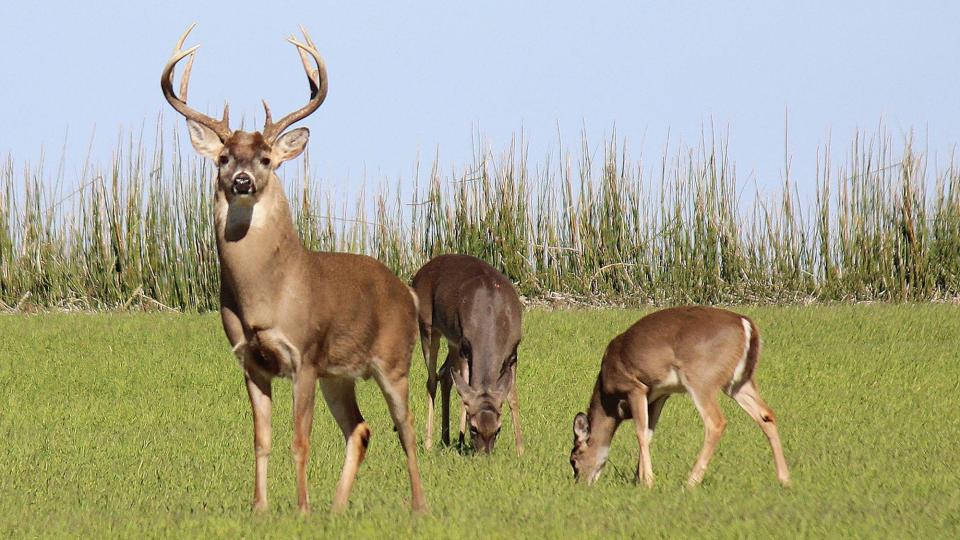Here's the risk deer pose to Kansas drivers, according to recent annual accident records
Hunters kill at least eight times as many deer in Kansas as drivers do.
Hunters shot 83,126 deer in the Sunflower State over the most recent 12-month period for which figures are available, in 2020-2021, while 10,024 deer-vehicle crashes were reported here in 2022, records show.
Still, Kansas ranks 20th among U.S. states in the likelihood that a driver here will strike a deer or other large animal, said the State Farm Mutual Automobile Insurance Co.
Its website said that over the 12-month period ending June 30, 2022, vehicles nationwide were reported involved in collisions with 1,378,542 deer, 235,836 unidentified animals, 101,949 rodents, 60,316 dogs and 56,096 raccoons.

Deer less likely to be hit in Kansas than in Missouri
A Kansas driver's likelihood of filing an animal-related claim was one in 96 for the time period involved, said the annual report by State Farm, which uses insurance claims to produce records regarding collisions involving wildlife.
Kansas drivers were less likely to hit large animals than those in neighboring Missouri, which ranked 10th nationwide with a driver's odds of hitting a deer or other large animal being one in 80, State Farm said.
But it said drivers in the Sunflower State were more likely to collide with large animals than in the neighboring states of Oklahoma, Nebraska and Colorado.
Those states respectively ranked 29th, 30th and 41st nationwide, with odds of one in 119, one in 128 and one in 240, State Farm said.
In which states are drivers most likely to hit deer?
West Virginia continues to top the list of states where a driver is most likely to collide with a large animal, with a likelihood of 1 in 35, State Farm said.
Behind that state, in order, are Montana, with odds of one in 44; South Dakota and Michigan, both at one in 51; and Wisconsin, at one in 54, it said.
State Farm said the months in which drivers are most likely to collide with large animals are, in order, November, October and December.
Which Kansas counties see the most car/deer crashes?
The next few weeks historically bring a spike in deer/vehicle crashes in Kansas, with those animals seeming to bolt into paths of oncoming cars from out of nowhere.
That's in part because deer are entering their mating season, when they move around more and pay less attention to vehicles, said the website of the Kansas Department of Wildlife and Parks.
Shawnee County was second among the state's 105 counties last year with 339 deer/vehicle accidents behind Butler County, which finished first with 361, said figures provided by the Kansas Department of Transportation.
Other Kansas counties among the top 10 were Sedgwick, with 328; Johnson, with 319; Cowley, with 315; Douglas, with 313; Reno, with 308; Miami, with 258; Montgomery, with 229; and Coffey, with 206, KDOT said.
Which Kansas counties see the most car/deer crash injuries?
The state last year saw 575 injuries and six fatalities from deer/vehicle crashes, KDOT said.
Cherokee, Cloud, Finney, Kingman, Marion and Stafford counties each saw one fatality.
Shawnee County saw the most people injured in deer/vehicle accident injuries of any Kansas county, with 28.
It was followed by Johnson County, with 27; Butler, 26; Cowley and Sedgwick, each with 24; Sumner, 20; Miami and Wilson, each with 16; and Crawford, Douglas and Riley, each with 15.
What should drivers do?
Drivers shouldn't swerve to avoid hitting a deer, as they might suffer even more severe consequences because of hitting another vehicle on the road or an obstacle off of it, the Kansas Department of Wildlife and Parks said.
Its website shared these other bits of advice about how drivers can reduce their chances of hitting a deer:
• Keep an eye out in particular for deer at dawn and dusk, when they are most active.
• Watch out for more than one deer, as they seldom travel alone.
• Reduce speed and be alert near wooded areas, green spaces or bodies of water where they may suddenly pop out onto the road.
• Drive using your bright lights, when possible, at night.
• Be extra careful while driving in areas where "deer crossing" signs are displayed.
Contact Tim Hrenchir at threnchir@gannett.com or 785-213-5934.
This article originally appeared on Topeka Capital-Journal: Shawnee and Reno in top 10 Kansas counties for car vs. deer accidents

